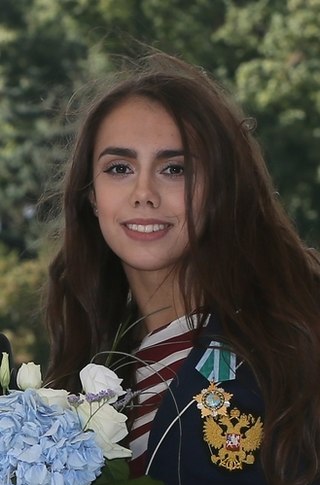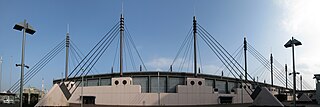
The ball is an apparatus used in the sport of rhythmic gymnastics. It is one of the five apparatuses utilized in this discipline, alongside the clubs, hoop, ribbon, and rope.

The ball is an apparatus used in the sport of rhythmic gymnastics. It is one of the five apparatuses utilized in this discipline, alongside the clubs, hoop, ribbon, and rope.
The rhythmic ball has evolved significantly since the inception of rhythmic gymnastics. The early forms of the sport, known as "group gymnastics" or "modern gymnastics," incorporated apparatus like balls, hoops, and ropes, which were used more for their utility in exercises rather than for performance artistry. For gymnastics, the ball originally began as a small ball around the size of a tennis ball and grew in size to make it easier for the audience to see and for the gymnast to roll along the body. [1]
The evolution of the rhythmic ball reflects the broader development of rhythmic gymnastics, emphasizing a blend of athleticism, artistry, and innovation.
The rhythmic ball is made from rubber or a synthetic material with similar properties. According to the Fédération Internationale de Gymnastique (FIG), the official specifications for the ball are as follows: [4]
The ball should not be grasped or held against the wrist during the routine. [4] One of the difficulties of working with the ball is keeping it balanced in the hand without gripping it. [5]
Gymnasts perform a variety of elements with the ball, including high or low throws, balancing the ball on a small area of the body, moving or catching it with a part of the body other than the hands, or holding it with a part of the body other than the hands during a body element. During the exercise, the gymnast should spend most of the time handling the ball with one hand. The elements that are considered to be particular to the ball are: [6]

Gymnastics is a type of sport that includes physical exercises requiring balance, strength, flexibility, agility, coordination, artistry and endurance. The movements involved in gymnastics contribute to the development of the arms, legs, shoulders, back, chest, and abdominal muscle groups. Gymnastics evolved from exercises used by the ancient Greeks that included skills for mounting and dismounting a horse, and from circus performance skills.

In gymnastics, the floor is a specially prepared exercise surface, considered an apparatus. It is used by both male and female gymnasts. The gymnastics event performed on the floor is called floor exercise. The English abbreviation for the event in gymnastics scoring is FX.

The balance beam is a rectangular artistic gymnastics apparatus and an event performed using the apparatus. The apparatus and the event are sometimes simply called "beam". The English abbreviation for the event in gymnastics scoring is BB. The balance beam is performed competitively only by female gymnasts.

Rhythmic gymnastics is a sport in which gymnasts perform on a floor with an apparatus: hoop, ball, clubs, ribbon and rope. The sport combines elements of gymnastics, dance and calisthenics; gymnasts must be strong, flexible, agile, dexterous and coordinated. Rhythmic gymnastics is governed by the International Gymnastics Federation (FiG), which first recognized it as a sport in 1963. It became an Olympic sport in 1984, with an individual all-around event. The group all-around competition was added to the Olympics in 1996. At the international level, rhythmic gymnastics is a women-only sport. The most prestigious competitions, besides the Olympic Games, are the World Championships, World Games, European Championships, European Games, the World Cup Series and the Grand Prix Series. Gymnasts are judged on their artistry, execution of skills, and difficulty of skills, for which they gain points. They perform leaps, balances, and rotations along with handling the apparatus.

The hoop is an apparatus used in the sport of rhythmic gymnastics. It is one of the five apparatuses utilized in this discipline, alongside the ball, clubs, ribbon, and rope.

The rope is an apparatus used in rhythmic gymnastics. Currently, the rope is not used in senior individual events, but it may be used in group competitions and juniors. The rope may be made of hemp or synthetic material which retains the qualities of lightness and suppleness. Its length is in proportion to the size of the gymnast. The rope should, when held down by the feet, reach both of the gymnasts' armpits. At the ends, there may be one or two knots and an anti-slip material to help the gymnast hold on. The rope may or may not be colored, but bright colors are preferred.

Twirling is a form of object manipulation where an object is twirled by one or two hands, the fingers or by other parts of the body. Twirling practice manipulates the object in circular or near circular patterns. It can also be done indirectly by the use of another object or objects as in the case of devil stick manipulation where handsticks are used. Twirling is performed as a hobby, sport, exercise or performance.
This is a general glossary of the terms used in the sport of gymnastics.

Evgeniya Olegovna Kanaeva OMF is a retired Russian individual rhythmic gymnast. She is the only individual rhythmic gymnast in history to win two Olympic all-around gold medals, winning at the 2008 Summer Olympics, where she finished with 3.75 points ahead of silver medalist Inna Zhukova, and at the 2012 Summer Olympics, where she also became the oldest gymnast to win the Olympic gold. On 4 July 2013, Kanaeva received the International Fair Play Award for "Sport and Life".

Melitina Dmitryevna Staniouta is a Belarusian retired individual rhythmic gymnast. She is a three-time World all-around bronze medalist, the 2015 European Games all-around bronze medalist, the 2014 European Championships all-around silver medalist, and 2009 Grand Prix Final all-around bronze medalist.

Margarita Mamun is a retired Russian individual rhythmic gymnast of Bangladeshi-Russian descent. She is the 2016 Olympic All-around champion, two-time World All-around silver medalist, the 2015 European Games All-around silver medalist, the 2016 European Championships All-around silver medalist, three-time Grand Prix Final All-around champion and a three-time (2011–2013) Russian National All-around champion.

Yana Alexeyevna Kudryavtseva is a retired Russian individual rhythmic gymnast. She is the 2016 Olympic All-around silver medalist, three-time World Champion in the All-around (2013–2015), the 2015 European Games All-around champion, two-time European Championships All-around champion, the 2012 European Junior ball champion. In national level, she is a two-time Russian National All-around champion and three time Russian Junior National all-around champion.

Linoy Ashram is a retired Israeli individual rhythmic gymnast. She is the 2020 Olympic All-around Champion, the 2018 World All-around silver medalist, two-time World All-around bronze medalist, the 2020 European All-around champion, and the 2019 European Games All-around silver medalist. She is the third Israeli athlete and first Israeli woman to win an Olympic gold medal in any sport, and the first Israeli rhythmic gymnast to win an Olympic medal. She became the first rhythmic gymnast from outside a post-Soviet republic to win a gold medal at an Olympics where former Soviet states participated. Ashram announced her retirement from competitive gymnastics at a press conference in Tel Aviv on 4 April 2022.
Alexandra Ana Maria Agiurgiuculese is a Romanian-Italian individual rhythmic gymnast who represents Italy. She is a World Championships silver and bronze medalist, and she competed at the 2020 Summer Olympics. Agiurgiuculese was the first Italian gymnast to win the Longines Prize for Elegance. At the national level, she is the 2019 Italian National all-around champion and three-time Italian National all-around silver medalist.

The 2018 Rhythmic Gymnastics World Championships were held in Sofia, Bulgaria, from 10 to 16 September 2018 at Arena Armeec. The top three countries in the group all-around, Russia, Italy, and Bulgaria won the first three spots for the 2020 Olympic Games. Russia was the most successful nation of the competition with seven of the nine gold medals, and Bulgaria and Italy each won a title.

The 2019 Rhythmic Gymnastics World Championships were held in Baku, Azerbaijan from 16 to 22 September 2019. The competition took place at the National Gymnastics Arena and served as a qualifier for the 2020 Olympic Games. There were Olympic berths awarded to 16 individuals and 5 groups. There were 301 participating athletes from 61 countries.

Ekaterina Olegovna Vedeneeva is a Slovenian individual rhythmic gymnast.

Sofia Raffaeli is an Italian individual rhythmic gymnast. She is the 2022 World all-around, hoop, ball, ribbon and team champion, the 2023 World all-around, hoop and ball silver medalist, the 2023 European ball and clubs champion and silver all-around medalist, the 2024 European ball champion and all-around and ribbon silver medalist and the 2022 European hoop and clubs champion. She is also the 2019 Junior World silver medalist with rope and clubs. She is the first Italian individual rhythmic gymnast to win a gold medal at the World Championships, European Championships and World Games, and she has won seven all-around gold medals in the FIG World Cup circuit.

The 2021 Rhythmic Gymnastics World Championships were held from 27 to 31 October 2021 in Kitakyushu, Japan.